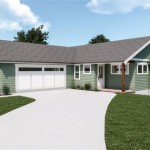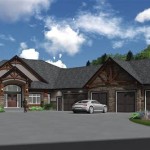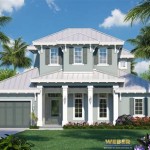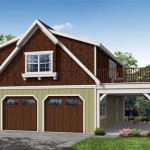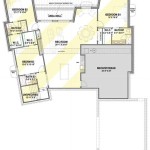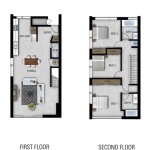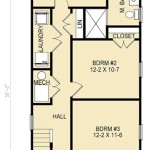Understanding the Appeal of One-Story House Floor Plans
One-story house floor plans, often referred to as ranch-style homes, offer a compelling alternative to multi-story dwellings. Their single-level design presents numerous advantages, appealing to a diverse range of homeowners. From accessibility and safety considerations to aesthetic flexibility and potential cost savings, the decision to opt for a one-story house plan involves careful consideration of lifestyle needs and long-term priorities.
The inherent simplicity of a single-level layout contributes significantly to its popularity. The absence of stairs eliminates a common obstacle for individuals with mobility limitations, making one-story homes particularly attractive to aging populations or those with physical disabilities. This inherent accessibility also translates to increased safety, reducing the risk of falls and injuries commonly associated with staircases, particularly for young children.
Furthermore, maintaining a one-story home is typically less demanding. Cleaning, repairs, and even moving furniture become considerably easier without the vertical challenges presented by multiple levels. This can translate to long-term cost savings, especially for homeowners who choose to perform routine maintenance tasks themselves.
Accessibility and Universal Design Principles
The most compelling advantage of a one-story house floor plan is its inherent accessibility. This characteristic makes it an ideal choice for individuals and families who prioritize ease of movement and long-term independence. Universal design principles, which aim to create spaces usable by people of all ages and abilities, are easily incorporated into a single-level layout.
Wide doorways and hallways, level thresholds, and accessible bathrooms are readily achievable in a one-story home. These features accommodate wheelchairs, walkers, and other mobility aids seamlessly. The absence of stairs eliminates the need for costly and potentially cumbersome stairlifts, providing a more integrated and aesthetically pleasing solution for individuals with mobility challenges.
Beyond immediate accessibility needs, a one-story home anticipates future requirements. As homeowners age, their mobility may decline, making a single-level living space a crucial factor in maintaining independence and avoiding the need for relocation. This proactive approach to housing ensures that the home remains a comfortable and functional environment throughout all stages of life.
Furthermore, the open-concept designs often associated with one-story homes further enhance accessibility. Minimizing walls and creating larger, interconnected spaces allows for easier navigation and maneuverability, promoting a sense of freedom and independence for all occupants.
Cost Considerations: Construction and Maintenance
The financial implications of choosing a one-story house floor plan involve a complex interplay of construction costs, energy efficiency, and long-term maintenance expenses. While the initial construction costs may appear higher compared to a similarly sized multi-story home, several factors contribute to potential long-term savings.
The foundation footprint of a one-story home is generally larger than that of a multi-story home with the same square footage. This translates to higher foundation costs and potentially increased costs for roofing materials. However, the simplified construction process associated with a single-level structure can offset these expenses.
Construction labor costs may be lower for a one-story home due to the reduced need for specialized trades and equipment required for multi-story construction. The absence of scaffolding and the simplified process of transporting materials to higher levels can contribute to significant cost savings.
Furthermore, one-story homes often exhibit improved energy efficiency. Heat rises, making it more challenging and expensive to heat multi-story homes. In a single-level dwelling, heat distribution is more uniform, reducing energy consumption and lowering utility bills. This is further enhanced when the layout is designed to maximize natural light and ventilation, reducing the reliance on artificial lighting and air conditioning.
Maintenance costs associated with a one-story home are typically lower. Exterior maintenance, such as painting and gutter cleaning, is simplified and less expensive without the need for ladders or specialized equipment. Roof repairs are also generally more accessible and less costly on a single-level structure.
Design Flexibility and Aesthetic Appeal
One-story house floor plans offer remarkable design flexibility, allowing for a wide range of architectural styles and customization options. From the classic ranch-style home to contemporary designs with open floor plans and expansive windows, the possibilities are virtually limitless.
The single-level layout allows for seamless integration of indoor and outdoor living spaces. Sliding glass doors, patios, and decks can be easily incorporated into the design, creating a harmonious transition between the interior and exterior environments. This feature is particularly appealing to homeowners who value outdoor entertaining and enjoy connecting with nature.
The absence of stairs allows for creative use of space. Vaulted ceilings, skylights, and large windows can be incorporated to maximize natural light and create a sense of spaciousness. Open floor plans, which are commonly associated with one-story homes, promote social interaction and create a more inclusive living environment.
Furthermore, the single-level design allows for greater flexibility in room placement. Bedrooms can be strategically located away from living areas for increased privacy, or clustered together to create a family-friendly zone. Kitchens can be designed as open-concept spaces that flow seamlessly into dining and living areas, or as separate, more private spaces depending on the homeowner's preferences.
The exterior aesthetic of a one-story home can be tailored to suit a variety of tastes. From traditional brick facades to modern stucco finishes, the possibilities are endless. Landscaping can be used to enhance the curb appeal of a one-story home, creating a welcoming and inviting atmosphere.
Considerations for lot size and orientation are important aspects of one-story home design. The larger footprint of a single-level dwelling requires a proportionally larger lot. Proper orientation of the home on the lot is crucial for maximizing natural light, ventilation, and energy efficiency.
In conclusion, one-story house floor plans represent a versatile and practical housing option that caters to a wide range of needs and preferences. Their inherent accessibility, potential cost savings, and design flexibility make them a compelling choice for homeowners seeking a comfortable, sustainable, and aesthetically pleasing living environment.

Elegant One Story Home 6994 4 Bedrooms And 2 Baths The House Designers Plans Floor

Unique One Story House Plans Monster

40 X 55 2 200 Sf One Story House Plan The Escape

Pin On Homes

Modern One Story House Plot 20x17 Meter With 2 Beds Pro Home Decors

Small One Story 2 Bedroom Retirement House Plans Houseplans Blog Com
House Plan Of The Week Simple One Story Design Builder

Stylish One Story House Plans Blog Eplans Com

Modern One Story House Plot 20x17 Meter With 2 Beds Pro Home Decorz

Stylish One Story House Plans Blog Eplans Com

